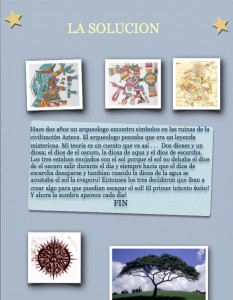Across cultures, stories about gods and heroes fall into the category of myths and legends. According to diffen.com, “…the two aren’t the same and can be differentiated based on factors such as reasons behind them, the stories behind them and the truth they hold.” The table below (from diffen.com) helps us distinguish between myths and legends. How do myths and legends fit into today’s technological world? Take an epic journey with your students as they explore this cultural topic through high and low tech activities and assessments.
Legend |
Myth |
|
| Is there evidence that the event occurred? | There may be proof to support the story as it reportedly happened during a specific historical time period. | There is no evidence or time frame to support that the people were real or the events in the myth actually occurred. |
| When and Where did it happen? | Past time or historical. Usually from a specific culture. | Past time and historical. Within a specific time period — usually ancient. |
| Is it fact or fiction? | Facts are distorted or exaggerated. Some fiction. | There is no evidence to prove it was fact. Fictional stories explaining how “the world was created” or some type of natural situation that occurred on Earth. |
| Who do they talk about? | Actual heroes or people who do admirable or heroic deeds. | Gods of ancient cultures. |
| What are they about? | Legends feature an actual cultural hero, but includes imaginative elements. | Traditional narrative that explains natural phenomena through symbolism — often involves the gods of ancient cultures. |
| What element is used? | Imaginative element is used to help explain or tell the story. | Symbolism is used to explain or demonstrate the natural “situation or event” that the story is about. |
My Spanish IV students participated in a presentational task during their study of legends and myths from the target culture. They were asked to compare and contrast these legends and myths with ones from their own culture. In doing so, they compared both the type of language used in these essays and the cultural significance of the legends and myths studied. Students then created an Orson Welles-like radio show after reading a short explanation of the radio program that aired in 1938. With the help of technology, students recorded their myths using mobile phones and Google Voice (high tech). These radio programs could also have been presented “live” in class (low tech). This formative assessment using the high tech Google Voice option was completed while I was attending a professional conference. Despite my absence, students were still working in the target language and providing me with assessable oral content. This process of students creating recordings in my absence also strengthened their technology literacy skills, helping to prepare them for college and careers (one of the important advantages of including high tech options).
Student examples:
Volcán:
Conejos Gigantes:
The student radio show was a building block to understanding the differences between myths and legends and their cultural impact. This first activity prepared students to read and interpret well-known myths from the target culture. Students needed to practice and use the structures for expressing the uncertainty, falsehoods, and exaggerated dialogue typically found in myths.
The myth activity was followed by a legends activity during which students closely read several legends from a number of Spanish-speaking countries (the sources were several online sites, the text we use and other readers). While reading, students identified an exaggeration and a truth by annotating, and reflected on the different expressions and vocabulary used across cultures. These linguistic and cultural comparisons were reinforced by the heritage speakers in my classes who shared connections they made to the beliefs within their own family. Students worked extensively with vocabulary, grammatical structures, and the structure of legends, applying what they learned to the writing of their own legends. They then read aloud and recorded their own legends, once again using Google voice (high tech) or reading live (low tech) to other classes. For this summative assessment, students created a legend to explain a chosen phenomenon of nature. Below you will find two student examples, a high tech poster created in Google docs (Glogster was also used by some students) and a low tech version created by hand.
One of my goals for the written legends activity is to have my students share their legends with younger students in elementary classrooms. In the future, I intend to connect my students to others in the community through visiting a local school (low tech) or Skyping/Facetiming (high tech) for this activity. The results would be effective both in building interaction and collaboration between students of different levels and backgrounds as well as leading to future project collaborations.
So what is your epic challenge? Find various myths and legends that connect with the target language that you teach and try some of these same ideas. It’s no myth that they will get your students communicating, reading, and writing in the target language. You and your students will be legendary!
Resources
Creative high tech tools for teachers and students
Use this WL Data Showcase site (created by two WAFLT Summer Institute presenters) to find creative tech tools to display what your students create with tech tools that you can also find here.



